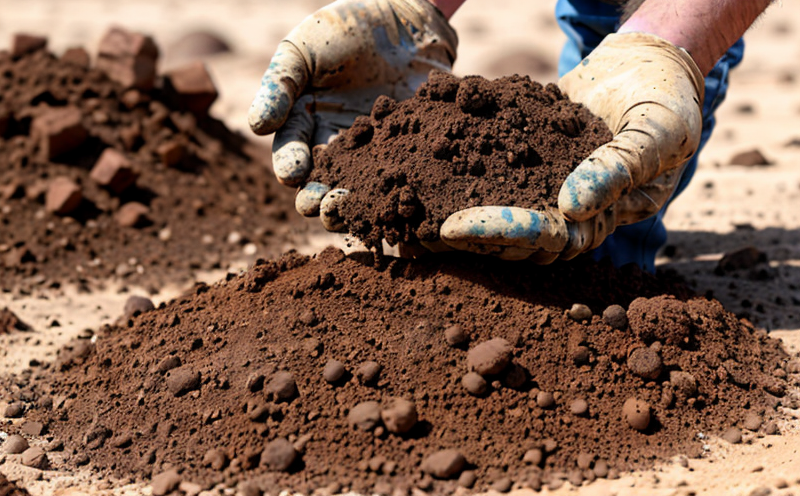ASTM D6913 Particle Size Analysis by Sieving Testing
The ASTM D6913 standard provides a precise method for analyzing particle size distribution in soil and overburden samples. This testing protocol is essential for ensuring that materials meet the specified requirements of various industries, including mining, construction, and environmental management.
Particle size analysis by sieving involves passing the sample through progressively finer sieves to determine the percentage of material retained on each sieve. The sieves are arranged in a stack with decreasing mesh sizes, starting from coarse to fine. The weight of the material remaining on each sieve is measured after shaking the sample for an appropriate duration.
The ASTM D6913 procedure ensures that the testing process is standardized across various laboratories. This standardization guarantees accurate and repeatable results, which are critical for quality control and compliance with industry regulations. By adhering to this protocol, mining companies can ensure that their materials meet the required specifications, enhancing product consistency and reliability.
The testing begins with sample preparation, where the soil or overburden is passed through a coarse sieve to remove oversized particles. The sample is then dried thoroughly according to ASTM D4221-08a, ensuring it reaches a constant weight before sieving. Once prepared, the sample is divided into increments of 50 grams for testing.
The sieves used in this test are typically available commercially and should meet the specifications outlined in ASTM D6913. The sieves have mesh sizes ranging from coarse (e.g., #4) to fine (#200), with the exact selection depending on the expected particle size distribution of the sample.
The testing process involves placing each increment into a separate sieve and shaking it for 15 minutes, or until the material no longer settles. After sieving, the retained particles are weighed accurately using an analytical balance capable of measuring to at least 0.001 grams. The percentage of material remaining on each sieve is then calculated.
It's important to note that ASTM D6913 specifies that the test should be conducted in a controlled environment to minimize environmental factors that could affect the results. This includes maintaining consistent temperature and humidity levels, as well as ensuring proper sample handling techniques.
The particle size distribution data obtained from this testing method is crucial for various applications within the mining sector. For instance, it helps in optimizing processing methods by identifying the optimal feed size for grinding machines or flotation processes. Additionally, understanding the particle size distribution aids in predicting the performance of materials in various environmental conditions, such as erosion resistance or stability under load.
The ASTM D6913 method is widely recognized and accepted across numerous industries due to its reliability and reproducibility. Its use ensures that all parties involved have a consistent basis for decision-making regarding material specifications and quality assurance.
By adhering to this standard, mining companies can ensure their products meet the required standards, thereby enhancing their reputation and competitive edge in the market.
Industry Applications
In the mining industry, ASTM D6913 particle size analysis by sieving is used to determine the optimal feed size for various processing methods such as grinding and flotation.
The test results also help in predicting material performance under different environmental conditions, which is crucial for ensuring product stability and reliability.
For construction projects involving soil or overburden materials, this analysis ensures that the specifications meet the required standards, enhancing project quality and safety.
In environmental management, ASTM D6913 particle size distribution data can be used to assess the potential impact of materials on ecosystems, aiding in sustainable practices.
The versatility of this testing method makes it an indispensable tool for industries reliant on accurate and consistent material specifications. By providing detailed insights into particle size distribution, ASTM D6913 supports informed decision-making processes across various sectors.
International Acceptance and Recognition
The ASTM D6913 standard is highly regarded globally for its robustness and reliability in particle size analysis. This international recognition stems from the stringent quality control measures implemented during testing, ensuring consistent results regardless of where the test is conducted.
ISO 17025-accredited laboratories adhere to this protocol to maintain high standards of accuracy and precision. Compliance with ASTM D6913 ensures that the particle size analysis meets international benchmarks, facilitating seamless collaboration between different entities within the mining sector.
The widespread adoption of ASTM D6913 in numerous countries underscores its importance as a universal standard for particle size analysis. Its acceptance by regulatory bodies and industry leaders reinforces its role in ensuring compliance with global standards.
By leveraging this internationally recognized method, companies can ensure that their products meet the highest quality standards, thereby enhancing their credibility and market position.





